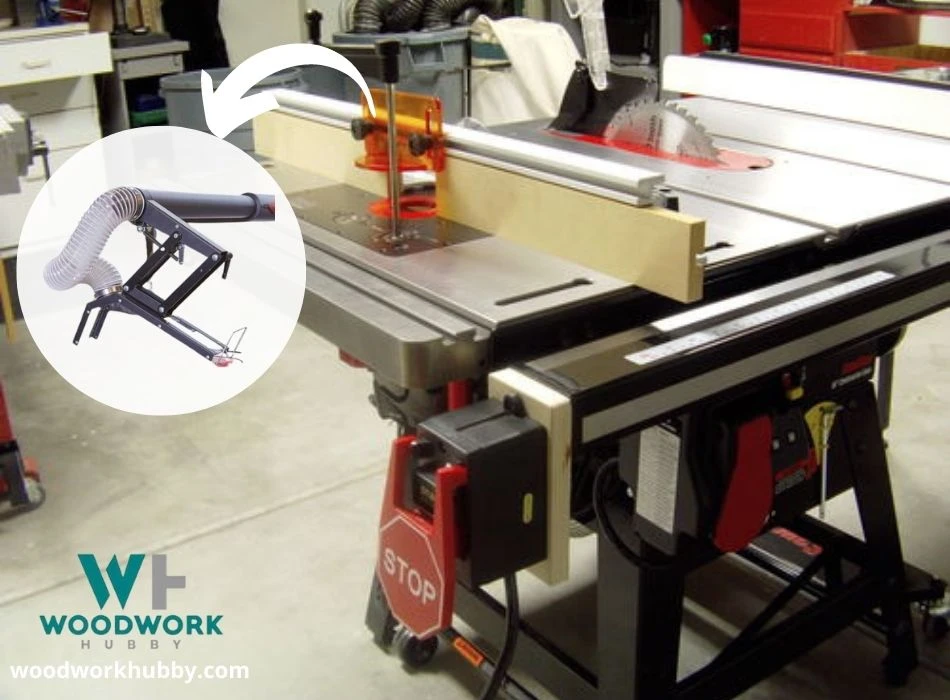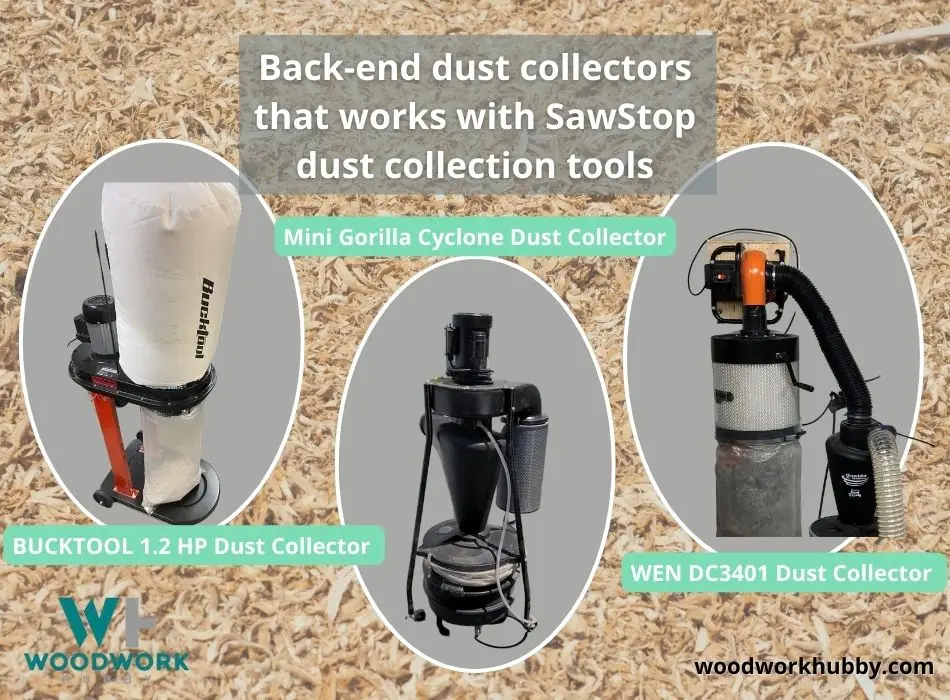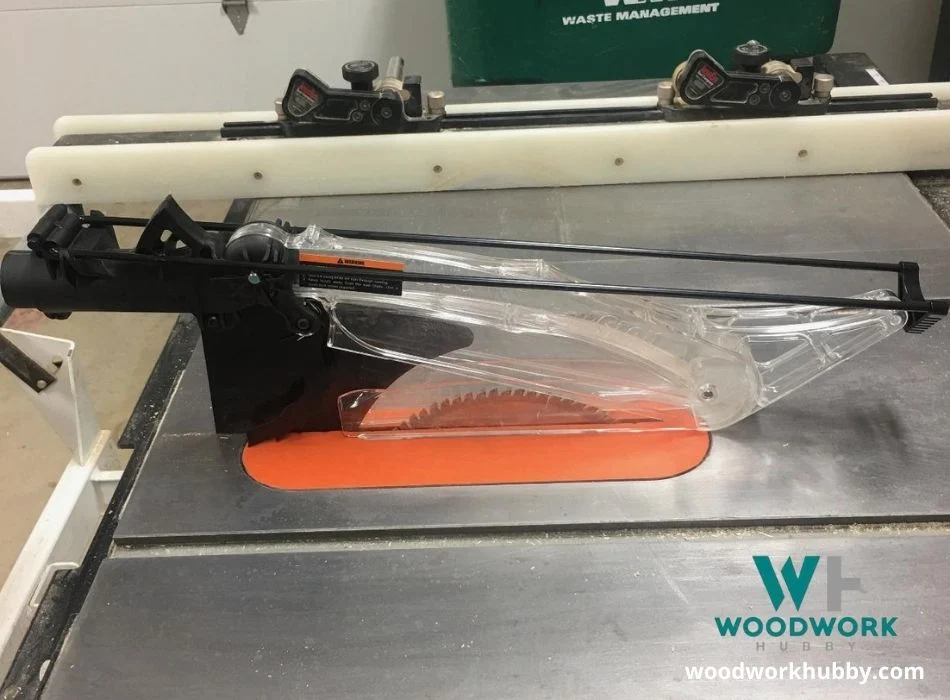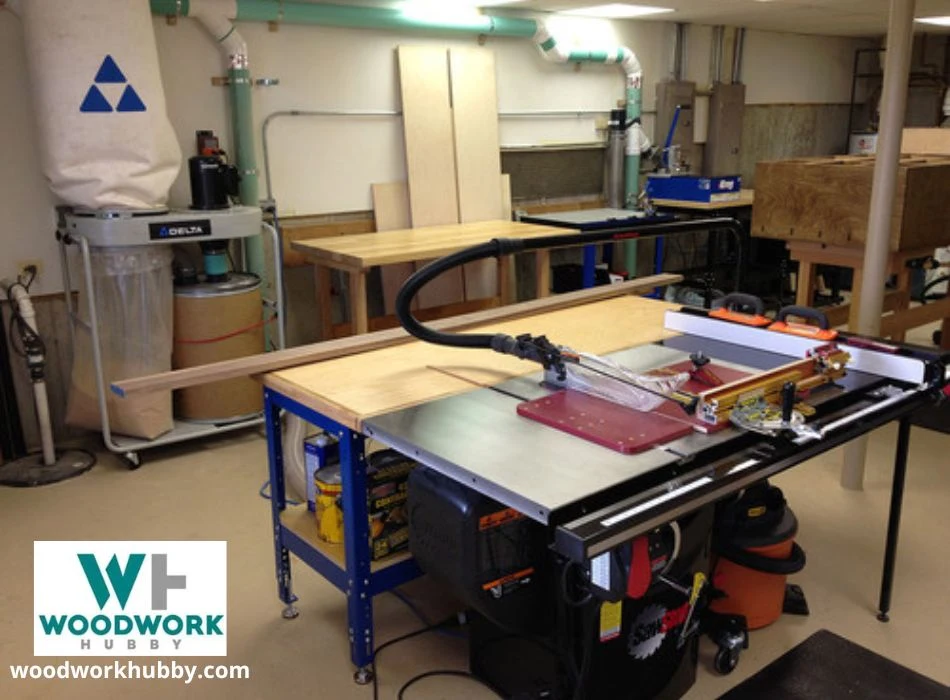If you’ve been dealing with heaps of sawdust on your table saw, or in your power tools, you probably need an automated dust collection system. A central air filter that produces a HEPA-compliant environment in your workshop would cost a fortune, so you probably rely on a dust collector like myself and most other woodworkers.
The best dust collector for SawStop is the Bucktool 1.2 HP system although any dust extractor that has at least 400+ CFM and a floating overarm blade guard will collect 99% of the dust. SawStop TSG-FDC dust collection guard can catch dust just as it is generated. When used with appropriate assembly, it can funnel the dust to any collector maintaining a clean workspace.
In this article, you will learn how you can improve dust collection in your workshop with blade guards and other means. You will also find out SawStop dust collection tools you should use to avoid sawdust heaps. But first, I’ll go over a few basics.
Sawstop Dust Collection: The Basics
If you have a workshop, you probably have a cleaning mechanism. Whether you use a shop vac to clear sawdust or have an external vent dust collector, what you need to understand is that sawdust is best collected as soon as it is generated.
Every dust collection system has a vacuum part. SawStop doesn’t manufacture those. The good thing about that is that SawStop dust collection tools will very likely work with your dust collector. Any dust collector with a 4″ port and 400 or higher CFM can work with SawStop dust collection tools.

So what does a SawStop dust collector do if it doesn’t have a vacuum suction mechanism? A SawStop dust collection blade guard makes sure that a majority of the dust gets captured as soon as it is generated. It is like an inlet for sawdust. But the pull of air that makes the dust travel to the collection bag or vent is generated by the back-end dust collector.
Before I get into SawStop dust collection tools, here are my top recommendations for back-end dust collectors. There are relevant only if you don’t already have a dust collector with a 4″ port.
These dust collectors are some that my friends and I have used and worked very well. The best dust collectors that work with SawStop collection guards are:

Sawstop Above Table Dust Collection Blade Guard
If you are tired of having to clean your table saw surface after each session, you can get SawStop Avoid Table Blade Guard, which gets 99% of the dust left on the table. It is ideal for projects that create a lot of sawdust but don’t disperse it at a rapid speed. The guard catches the dust almost immediately, giving it no room to be blown away by the blade’s speed.

Its simultaneous dust collection frees you up to work for longer periods. Often blade guards are notorious for limiting the minimum leanness of a cut. This blade guard can accommodate cuts that are as narrow as 3/4th of an inch (1.9 cm).
Sawstop Above Table Dust Collection Blade Guard
It fits directly into conventional dust collector systems, which means that you might not have to upgrade your shop’s dust collection mechanism beyond a dust guard. It also comes with a one-year warranty.
It has over a hundred reviews and ratings on amazon, which collectively add up to a 4.4-star average on a 5-star scale. This is above average but not an excellent rating. And here’s the reason.
The Sawstop Dust Collection Blade Guard is well-received for being one of the cheapest SawStop dust collection improvement products on the market. But at the end of the day, it isn’t a collection system but just a collecting contraption.
While it can catch 99% of the sawdust that the sawing action generates, its effectiveness depends on the specific dust collector used. To get it to work at its optimum potential, you need a SawStop Overarm Dust Collection mechanism.
A video showing the efficiency of SawStop Professional Cabinet Saw – Dust Collection.
Over-Arm Dust Collection Assembly – TSA-ODC
The overarm dust collection assembly can help funnel sawdust from the workbench to the dust collector. It requires a dust-collecting blade guard to work. When you buy a blade guard, one of the most common problems you run into is the compatibility issue. SawStop saws are often a subject of this incompatibility discussion. Belonging to the same brand, this dust collector assembly works with 36-inch and 52-inch SawStop contractor saws.

It unifies the dust collection ports into a 4″ single port, which works with standard dust collectors. For this, you need above collection and below-table dust collection mechanisms, though. The Y-port is conducive to two inlets.
Its ease of assembly is rated 4.5 stars on a 5-star scale, which is pretty promising for a website like Amazon, where plenty of novices shop.
It will work perfectly with any 400 CFM+ Dust collector. The collector doesn’t have to be a SawStop-branded one as long as the blade guard and the assembly are SawStop-branded.
Over-Arm Dust Collection Assembly – TSA-ODC
Sawstop Tsg-Fdc Floating Overarm Dust Collection
Unlike the previous products that make SawStop dust collection accessible to regular dust collectors, this one is a plug-and-play collection system that comes with a blade guard and assembly. You still need a standard dust collector to create the vacuum for the system to work.
And a shop vac won’t work because its port size isn’t 4″. But most dust collectors have a 4″ port and can work with SawStop TSG-FDC.
It has a 4.3-star average rating, the highest for any SawStop dust collection device on Amazon. This is perhaps because of the mobility and versatility of this floating overarm collector. The saw can move in pretty much any direction, which is impossible with a classic tool vac.
Sawstop Tsg-Fdc Floating Overarm Dust Collection
But like all collection guards and assemblies, the ultimate credit for suction and vacuuming goes to the dust collector on the back end. A 400-CFM dust collector with a 4″ port is recommended for this.
How Do I Increase My SawStop Dust Collection?
You can increase SawStop dust collection by using a dust tray, an overarm collector, and a dust collector hose. If the efficiency of your dust collector is the problem, then upgrading to a higher CFM dust collector can be an excellent solution.
Now let’s look at each one of these ways and go over the context where they are respectively appropriate.
Add A Dust Collection Tray
A dust collection tray can keep your shop floor from getting dirty. If the biggest annoyance you have with your SawStop is that you have to broom your shop floor, then a collection tray will fix your problem. Saw dust gets everywhere, depending on how fine it is. From your eyebrows to your apron, nothing is safe from sawdust. But eventually, the dust has to fall down, thanks to gravity.
Thick sawdust particles don’t get the chance to fly high enough to get lodged anywhere or even get breathed in. They fall down pretty quickly and are best collected with a tray extension. Finer dust disperses too much before it falls, so the tray is inefficient for its collection.
Add An Overarm Dust Collector
As heavy dust settles quickly, forming heaps, finer dust has the escape velocity to be airborne. It can get in the eyes and the nose, so it can be particularly annoying. An overarm dust collector can collect dust by pulling it up and flowing it away.
Heavy sawdust and wood chips can’t be collected by an overarm dust collector unless its CFM is high enough to make heavier chunks fly.
Is SawStop Overarm Dust Collector Worth It?
A SawStop overarm dust collector is worth it if you’re looking to get rid of fine sawdust produced by high-speed sawing. It is not excellent at collecting heavier wood chips but works well as a general-purpose, table-wide dust collector.
Use A Dust Collector Hose With Your Tool
A common way to get dust collected almost immediately, regardless of its lightness or heaviness, is the dust collector hose. When a hose can vent dust from the precipice of the cutting tool, you can get it away as quickly as the CFM of the collector allows.
Upgrade Your Dust Collector To A Higher CFM
CFM refers to the speed at which air flows through a dust collector. Regardless of the suction position, CFM decides whether or not dust gets carried into the vent. If you don’t vent outside your shop, then the precision of your filter is just as important because. Dust that escapes the filter can be airborne.
How Many CFM Does A SawStop Need For Dust Collection?
A SawStop dust collector hose CFM needs to be 100 times the diameter of the tube (in inches). So, a dust collector with a typical 4″ hose would need 400 CFM at a minimum to function properly.
What Size Is The Dust Port On A SawStop Saw?
SawStop saws have a 4″ dust port, which is standard and can fit a standard dust collection system. You must ensure that the dust collector runs at over 400 CFM, or the dust might start settling in the hose before being fetched far enough into the filter system.
Can I Use A Shop Vac As A Dust Collector?
You can use a shop vac for primary dust collection, but to use it as a central dust collector, you need to modify it so that its dust collection is more automated and covers an area without being continuously aimed. It is definitely possible to turn a shop vac into a standalone dust collector.
A video showing how to make a dust collector with a wet/dry vac.
The video above shows how you can get a shop vac to function as a dust collector. That said, its efficiency is understandably lower than that of a standard dust collector. Moreover, it works for smaller shops only. The larger the space, the poorer a shop vac is as a central dust collector.
8 Tips To Improve Sawstop Dust Collection
Now that I have covered some of the best dust collectors for SawStop, as well as the questions most people have regarding SawStop dust collection, let’s recap some of the dust collection hacks discussed earlier.
- Use a dust collector tray to get heavier sawdust – Wood chips and coarse dust doesn’t always get picked up easily.
- An overarm collector can get fine dust before it disperses – Dust that spreads wide and upward can create a mess.
- Get a high CFM to improve dust collection – 400 CFM is the minimum for a typical 4″ hose.
- Do not let the dust collection hose be any larger than 4″ – A broader hose reduces the overall air pressure.
- Clean the filter regularly to improve dust collection efficiency – If the filter is clogged or the dust collection bag is full, the airflow will be negatively affected.
- If a central dust collector isn’t feasible, convert your shop vac into a precise dust collector – You can turn your shop vac into a small dust collector that can pick up sawdust from your SawStop.
- Audit for leaks in your current dust collection mechanism – If there is even a minor leak in your dust collection hose, the airflow gets compromised, and not enough dust is collected.
- Know when it is time to ditch the old dust collector – There is only so far you can go with dust collector upgrades. At some point, you have to get a better dust collector.
Final Thoughts
A SawStop TSG-FDC Table Saw dust collection system used with a WEN DC3401 660 CFM dust collector motor would provide the right sawdust clearance and collection for your workshop. If you’re on a tight budget, then get a SawStop collection guard and use your current dust collector with it.










